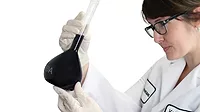Effectively immobilizing PFAS within an AFFF source zone using colloidal activated carbon
Pilot study demonstrates treating PFAS with CAC at the air-water interface eliminates PFAS mass flux into groundwater — halting further plume development.
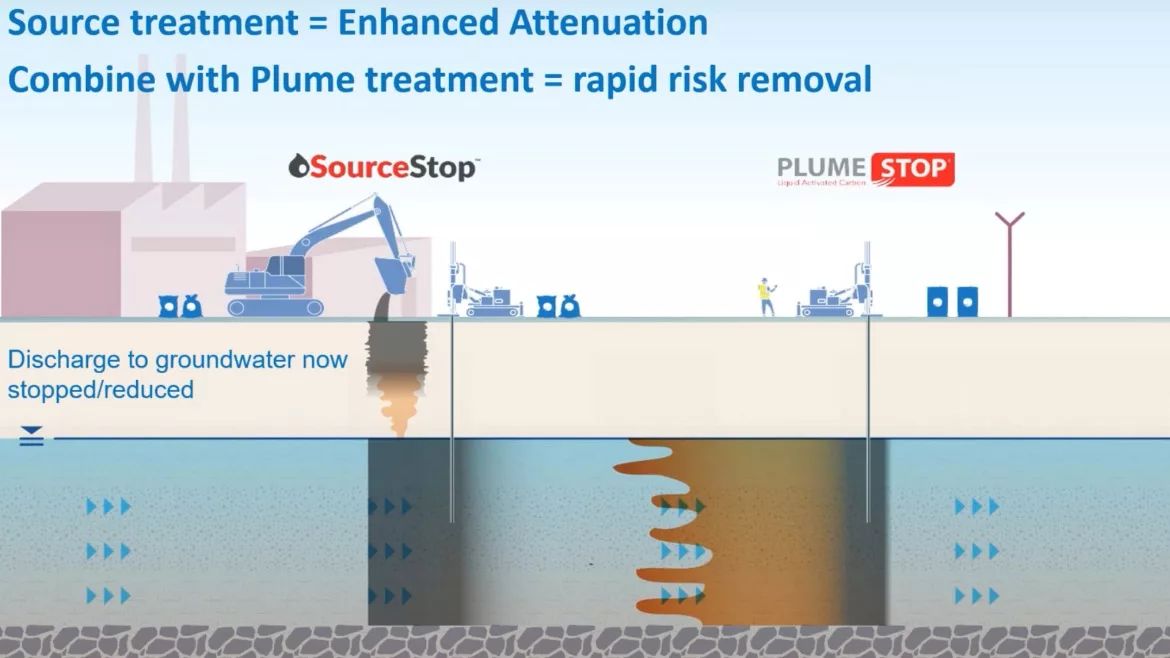
In Situ Remediation Services Ltd. (IRSL), a leading environmental remediation company based in Canada, has recently completed a pilot study, demonstrating how PFAS are effectively treated in the capillary fringe of an AFFF source zone by in situ injection using Colloidal Activated Carbon (CAC). The approach offers a means to improve efficiency, while reducing the cost to remediate PFAS-contaminated sites.
The Challenges of PFAS Remediation
Treating PFAS in groundwater presents formidable challenges, with few remedial options that have documented success. Remediation approaches that are effective for other organic contaminants, including bioremediation and chemical oxidation, are ineffective against PFAS due to their carbon-fluorine bond strength.
PFAS' stability allows the contaminants to readily migrate through groundwater unabated, forming large, low-concentration plumes extending for up to miles in the subsurface. PFAS forward-diffuse into lower conductivity aquifer soils along these plumes, providing contaminant reservoirs that bleed out and sustain these plumes (i.e., matrix back-diffusion) for lifetimes.
Given the size of PFAS plumes and cleanup targets in the parts-per-trillion range, PFAS remedies must be highly efficient to prevent astronomical costs. Enhanced attenuation strategies, where highly concentrated PFAS source zones are treated to eliminate contaminant flux, prevent further plume development. Most large non-PFAS contaminant plumes are managed using this approach.
PFAS Distribution in AFFF Source Zones
Firefighting training sites where aqueous film-forming foams (AFFF) were repeatedly discharged to the ground are some of the most highly concentrated sources of PFAS. Within these AFFF source zones, PFAS' surfactant properties cause them to be highly concentrated at the air-water interface (a.k.a., the capillary fringe) –usually orders of magnitude greater than in the plume body.
As the air-water interface in a source zone occupies only a fraction of a PFAS plume's total volume, remedies that can cost-effectively target and immobilize PFAS at this interface can significantly improve remediation efficiency and substantially reduce project life-cycle costs. To test this concept, IRSL conducted a pilot study using CAC to treat PFAS at the air-water interface within an AFFF source zone. Rick McGregor, President and CEO of IRSL, led the study and recently presented it in a REGENESIS®-hosted webinar, briefly recapped below.
Pilot Study: In Situ Treatment of PFAS at the Air-Water Interface
The study was conducted at a site in Central Canada in a former firefighting training area where AFFF was discharged at the ground surface, leaching PFAS into the groundwater. The water table was unconfined and shallow (~18 feet deep), favorable conditions for the in situ injection approach.
Before injection, baseline samples were collected from the shallow groundwater and the pore water and analyzed for PFAS. Six PFAS were detected, with contaminant mass dominated by C-5 and C-6 compounds. PFAS concentrations in the pore water were an order of magnitude greater than in the shallow groundwater (Table 1).
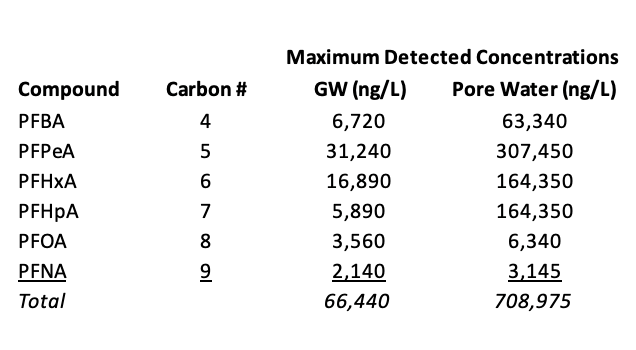 Table 1: Baseline concentrations of PFAS in the pilot study area.
Table 1: Baseline concentrations of PFAS in the pilot study area. CAC was applied to the treatment zone through twenty-three direct push injection points spaced 6 feet apart (Figure 1). Approximately 2,100 gallons of PlumeStop® CAC solution were injected, effectively coating the matrix across the air-water interface with micron-scale carbon particles.
IRSL collected soil cores before and after injection, sampling them for total organic carbon (TOC) to assess CAC distribution (Figure 1). A network of monitoring wells and lysimeters (Figure 2) were used to measure PFAS concentration changes in the shallow groundwater and pore water, respectively. Performance monitoring data were collected over 18 months, with the first performance sampling event conducted 107 days post-injection.
Pilot Study Details
- Study area - approximately 1,080 square feet
- Target vertical interval - 18.4 to 20.3 feet bgs
- Site geology/hydrogeology
- aquifer materials - glacial-fluvial deposited, sand to silty sands
- conductivity - 10-4 to 9 x 10-2 centimeters per second
- groundwater velocity - 50 feet/year
- Contaminants treated - PFAS
- CAC Mass/Solution injected - 1,760 lbs/2,100 gallons
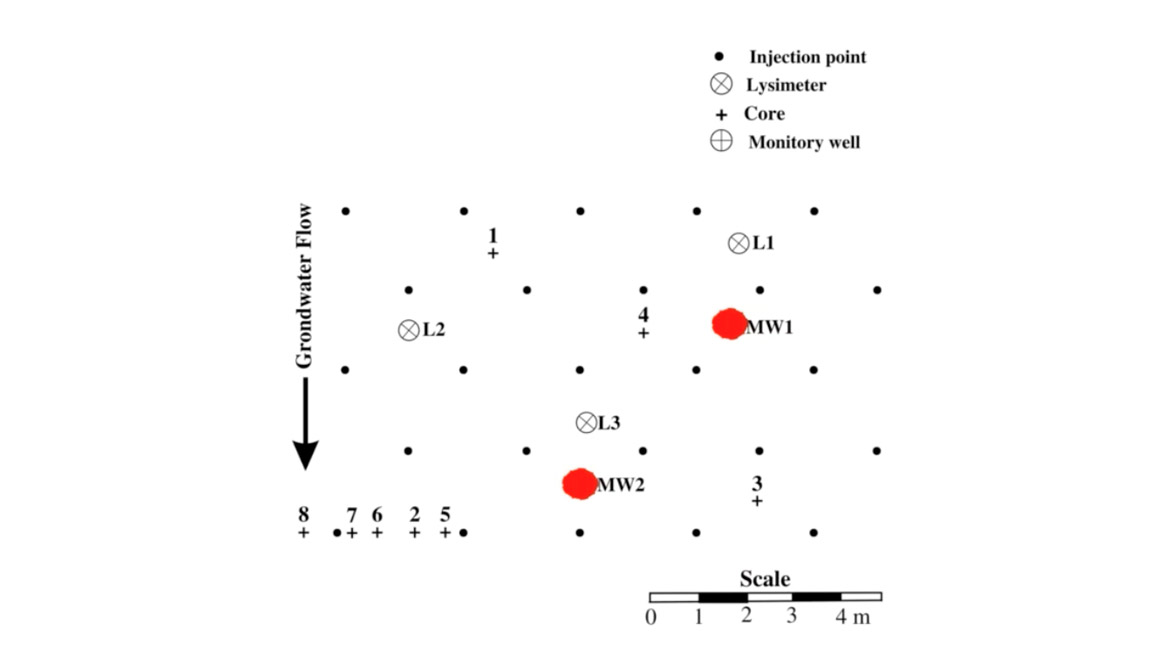 Figure 1. Plan view layout of the pilot study area depicting locations of injection points, performance monitoring wells, soil cores, and lysimeters.
Figure 1. Plan view layout of the pilot study area depicting locations of injection points, performance monitoring wells, soil cores, and lysimeters.
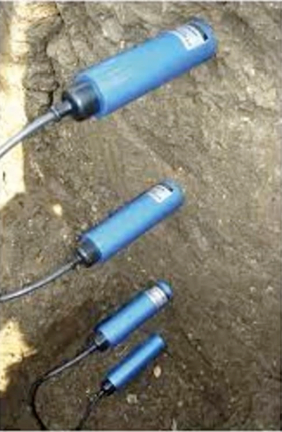 Pilot Study Results
Pilot Study Results
The performance monitoring data collected during the pilot test demonstrates the following:
- CAC Achieves Full Coverage in Treatment Zone - Over 90% of the injected CAC was confined to the target treatment zone while fully achieving over 8 feet lateral distribution through the zone.
- PFAS Eliminated in Pore Water (Lysimeter Data)- All PFAS were reduced to non-detect by the first monitoring event (i.e., 100 days). PFAS remained non-detect through the end of the 18-month monitoring period, except PFPeA, a short-chain (five-carbon) PFAS, which rebounded to less than 1% of its baseline concentration at the 18-month event (Figure 3).
- PFAS Mass Flux Drastically Reduced in Shallow Groundwater (Monitoring Well Data) - PFAS concentrations (and mass-flux) were substantially reduced, ranging from 81% PFBA reduction to 97% PFOA reduction through 18 months.
The pilot study demonstrates that treating PFAS with CAC, in situ, at the air-water interface offers a practical and effective means to eliminate PFAS mass flux into groundwater and halt further plume development. The low-cost approach can be integrated into a successful and efficient source-plume management strategy to eliminate PFAS exposure risk and liability.
McGregor intends to publish the pilot study in its entirety following peer review, adding to a growing list of research evaluating the efficacy of in situ remediation of PFAS.
Caption for figure 2: Lysimeters were used to measure PFAS concentrations in the pore water.
Optimizing the Enhanced Attenuation of PFAS Source-Plume Systems
The pilot study reveals AFFF source zones may harbor PFAS concentrations equivalent to or surpass part-per-million levels. However, PFAS compounds make up a minor proportion of the overall contaminant mass in these regions. Residual hydrocarbons, remnants of the burning fuels, are typically present at significantly higher concentrations.
A new, concentrated CAC technology (SourceStop®) immobilizes PFAS beneath AFFF source zones or other high-concentration areas. Its application penetrates the underlying soils and coats vertical flow paths, capturing residual contaminants and forming a horizontal barrier that prevents PFAS leaching and plume development.
SourceStop CAC is incorporated into sequestration and stabilization treatments at PFAS source zones, part of REGENESIS' enhanced attenuation approach to prevent PFAS exposure risk and liabilities long-term. These source zone treatments may cause a PFAS plume to stabilize, documented through a monitored natural attenuation (MNA) program. Alternatively, they may be combined with PlumeStop CAC permeable reactive barriers (PRBs) placed in the body or at the edge of a plume to prevent plume migration and eliminate risk (Figure 4).
Through the in situ application of these proprietary CAC technologies, the natural attenuation of PFAS plumes is made feasible, replacing pump-and-treat-based remedies long recognized as "expensive and ineffective" with a practical, sustainable, and cost-effective approach for managing PFAS liabilities and risk.
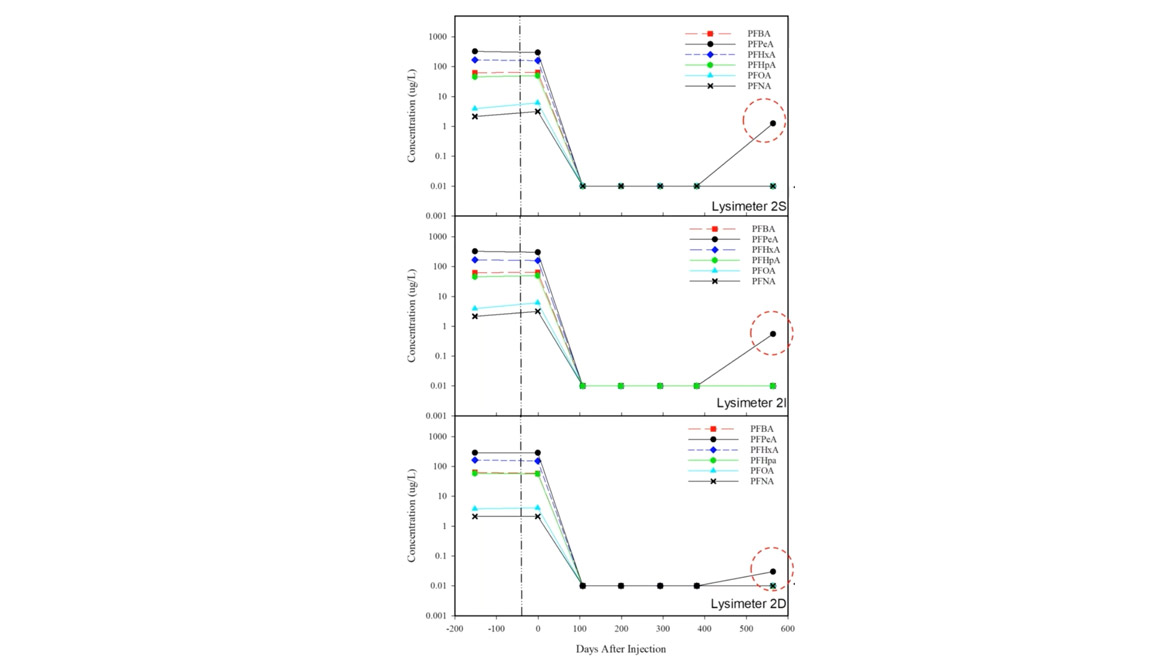 Figure 3 - PFAS in pore water at lysimeter cluster 2 (2S, 2I, and 2D), pre- and post-CAC-injection. The remaining two lysimeter clusters used for the study show similar results.
Figure 3 - PFAS in pore water at lysimeter cluster 2 (2S, 2I, and 2D), pre- and post-CAC-injection. The remaining two lysimeter clusters used for the study show similar results.


.webp?height=200&t=1720617286&width=200)

